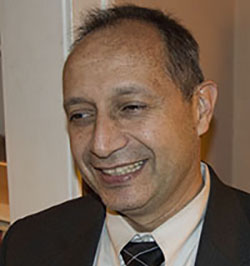Faculty - Dr. Edmundo Garcia

Professor of Physics
Associate Provost of Research and Grants Administration
|
|
| Education |
| B.S., Universidad Nacional Autonoma de Mexico (UNAM) |
| Ph.D., University of Maryland University of Maryland Institute for Physical Science
and Technology |
| Postdoctoral fellowship, Brookhaven National Laboratory & University of Maryland |
|
Research Interests
My area of scientific research is experimental high-energy nuclear physics, also often
called high-energy "heavy-ion" physics. This research is primarily carried out at
CERN, in Geneva Switzerland. We utilize large particle accelerators (or colliders)
to collide "heavy-ion" nuclei such as gold and lead traveling at near the speed of
light in order to re-create the conditions of the early universe in the laboratory.
By doing this we are able to melt normal nuclear matter, the protons, and neutrons,
into a "plasma" of quarks and gluons in order to study, and better understand, the
strong force and the theory of Quantum Chromo-Dynamics.
Representative Presentations & Publications
- Garcia, E., Cesalien, O., Harton, A., & Sagerer, J. (2022). Detector development tests
for the NAUM (Non-invasive Archaeometry Using Muons) program. Bulletin of the American
Physical Society.
- Stempek, R., Morgan, I., Melikyan, Y., Slupecki, M., Harton, A., & Garcia-Solis, E.
(2020). Acceptance tests of Fast Interaction Trigger modules for the upgrade of the
ALICE experiment. Bulletin of the American Physical Society, 65.
Representative Grants & Funding
- NSF Award to lead research in cutting-edge technology along with Dominican University
(DU) through a $646,093 to map archaeological pyramid structures in Mexico.
- NSF Award of $225,000 to support the ALICE research program at CERN until the summer
of 2016 "Studies of Relativistic heavy Ion Collisions in ALICE at the LHC
Memberships
- American Physical Society
- National Society of Hispanic Physicists
<< Back


 All Rights Reserved
All Rights Reserved